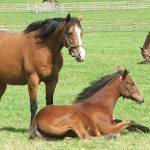Weaning: Nutritional Factors for the Mare

When a mare gives birth, the foal is completely dependent on her milk for its nutrient and energy needs. A healthy, properly nourished mare produces 3-4% of her body weight in milk per day. For an 1,100-lb (500-kg) mare, that could be 33-44 pounds of milk every day!
Thus, the mare’s energy and protein needs double and triple, respectively, in the first three months of lactation. By the fourth month of lactation, mare’s milk meets only about 30% of the foal’s nutritional needs. The volume of milk begins to decline slightly, but the nutritional value decreases considerably both as part of the natural weaning process and the foal’s transition to more forage and grain concentrates. Consequently, the mare’s nutritional needs change as well.
As the mare enters late lactation, 4 to 6 months after foaling, her nutrient and energy needs decline. No scientific evidence proves that complete removal of concentrates in the days leading up to weaning speeds the drying-up process, although doing so is not an unusual practice. The absence or decline of suckling will decrease milk production, though. Milking the mare is not recommended after weaning, as this stimulus encourages the body to continue to produce milk. If the udder is still full and tight four days after weaning, a veterinarian should be consulted to rule out mastitis.
If the mare has been rebred, it is likely that, at weaning time, she has once again reached midgestation. “This is the time when the mare’s energy needs begin to slowly climb during pregnancy,” said Catherine Whitehouse, M.S., a nutrition advisor for Kentucky Equine Research. A balance between maintaining the mare’s nutrient needs and decreasing her intake in late lactation should be carefully monitored. Gradual changes leading up to and following weaning are ideal. Sudden, drastic dietary changes should be avoided.
Little research has focused on the nutritional needs of mares in the post-weaning period. All mares, even those on the best nutritional programs, appear to mobilize their own body stores of nutrients during lactation, especially bone mineral. The post-weaning period is therefore considered an important time for replenishment, even if she is pregnant. Additionally, if a mare ends lactation below a body condition score of 5, she should be fed to achieve appropriate weight gain before winter, and certainly before being rebred. A body condition score of 5-6 is appropriate for a broodmare. If a mare is too thin, she may have difficulty conceiving. Mares that are too fat will have added strain on skeletal structures throughout pregnancy and may experience more fatigue during foaling.
Exercise is important for mares at weaning. It is not advisable to keep them stall-bound after weaning and is preferable to allow them access to move freely and graze. This type of natural, light exercise may facilitate the drying-up process. Movement can help alleviate udder edema and promote healing.
In sum, the mare’s nutritional needs vary during early and late lactation as well as after weaning. Close attention should be given to body condition and nutritional balance of the diet. A Kentucky Equine Research nutrition consultant can guide you on how to properly nourish your mare through the various stages of pregnancy and lactation.
For more information about proper nutrition of breeding horses, check out the 48-page booklet Nutritional Management of Horses on a Breeding Farm.








